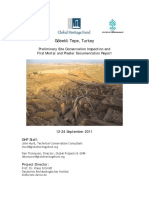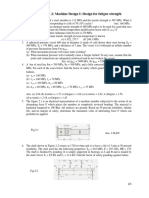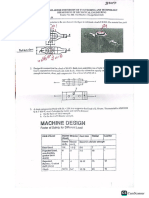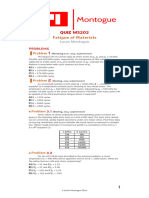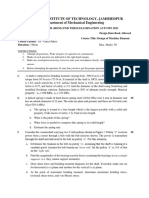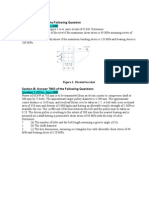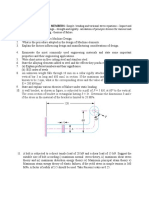Tut 1 CH 6
Tut 1 CH 6
Uploaded by
SpidyCopyright:
Available Formats
Tut 1 CH 6
Tut 1 CH 6
Uploaded by
SpidyOriginal Title
Copyright
Available Formats
Share this document
Did you find this document useful?
Is this content inappropriate?
Copyright:
Available Formats
Tut 1 CH 6
Tut 1 CH 6
Uploaded by
SpidyCopyright:
Available Formats
INSTITUTE OF ENGINEERING
THAPATHALI CAMPUS
DEPARTMENT OF AUTOMOBILE AND
MECHANICAL ENGINEERING
MACHINE DESIGN I
[TUTORIAL SHEETS]
AUTOMOBILE & MECHANICAL (III/I & III/II)
Prepared by: Lecturer Sunil Adhikari
TUTORIAL 1
FATIGUE FAILURE
6.1 A 10-mm drill rod was heat-treated and ground. The measured hardness was found to be 300
Brinell. Estimate the endurance strength in MPa if the rod is used in rotating bending.
6.3 A steel rotating-beam test specimen has an ultimate strength of 840 MPa. Estimate the life of
the specimen if it is tested at a completely reversed stress amplitude of 490 MPa.
6.5 A steel rotating-beam test specimen has an ultimate strength of 1610 MPa. Estimate the
fatigue strength corresponding to a life of 150 kcycles of stress reversal.
6.9 For the interval 103 ≤ N ≤ 106 cycles, develop an expression for the axial fatigue strength
(S’f)ax for the polished specimens of 4130 used to obtain Fig. 6–10. The ultimate strength is Sut =
875 MPa and the endurance limit is (Se’)ax = 350 MPa.
6.15 A solid round bar with diameter of 50 mm has a groove cut to a diameter of 45 mm, with a
radius of 2.5 mm. The bar is not rotating. The bar is loaded with a repeated bending load that
causes the bending moment at the groove to fluctuate between 0 and 2825 N.m. The bar is hot-
rolled AISI 1095, but the groove has been machined. Determine the factor of safety for fatigue
based on infinite life and the factor of safety for yielding.
6.17 The shaft shown in the figure is machined from AISI 1040 CD steel. The shaft rotates at
1600 rpm and is supported in rolling bearings at A and B. The applied forces are F1 = 10 kN and
F2 = 4 kN. Determine the minimum fatigue factor of safety based on achieving infinite life. If
infinite life is not predicted, estimate the number of cycles to failure. Also check for yielding.
(dimensions are in mm)
6.20 A bar of steel has the minimum properties Se = 276 MPa, Sy = 413 MPa, and Sut = 551 MPa.
The bar is subjected to a steady torsional stress of 103 MPa and an alternating bending stress of
172 MPa. Find the factor of safety guarding against a static failure, and either the factor of safety
guarding against a fatigue failure or the expected life of the part. For the fatigue analysis use:
(a) Modified Goodman criterion.
(b) Gerber criterion.
Prepared by: Lecturer Sunil Adhikari
(c) ASME-elliptic criterion.
6.24 Repeat Prob. 6–20 but with an alternating torsional stress of 103 MPa and a steady bending
stress of 103 MPa.
6.25 The cold-drawn AISI 1040 steel bar shown in the figure is subjected to a completely
reversed axial load fluctuating between 28 kN in compression to 28 kN in tension. Estimate the
fatigue factor of safety based on achieving infinite life and the yielding factor of safety. If
infinite life is not predicted, estimate the number of cycles to failure.
6.30 The figure shows the free-body diagram of a connecting-link portion having stress
concentration at three sections. The dimensions are r = 6 mm, d = 20 mm, h = 12 mm, w1 = 90
mm, and w2 = 60 mm. The forces F fluctuate between a tension of 18 kN and a compression of
72 kN. Neglect column action and find the least factor of safety if the material is cold-drawn
AISI 1018 steel.
6.33 The torsional coupling in the figure is composed of a curved beam of square cross section
that is welded to an input shaft and output plate. A torque is applied to the shaft and cycles from
zero to T. The cross section of the beam has dimensions of 5 × 5 mm, and the centroidal axis of
the beam describes a curve of the form r = 0.75 + 0.4375 θ/π, where r and θ are in mm and
radians, respectively (0 ≤ θ ≤ 4π). The curved beam has a machined surface with yield and
ultimate strength valuesof 420 and 770 MPa, respectively.
(a)Determine the maximum allowable value of T such that the coupling will have an infinite life
with a factor of safety, n = 3, using the modified Goodman criterion.
(b) Repeat part (a) using the Gerber criterion.
(c) Using T found in part (b), determine the factor of safety guarding against yield.
Prepared by: Lecturer Sunil Adhikari
6.35 A part is loaded with a combination of bending, axial, and torsion such that the following
stresses are created at a particular location:
Bending: Completely reversed, with a maximum stress of 60 MPa
Axial: Constant stress of 20 MPa
Torsion: Repeated load, varying from 0 MPa to 50 MPa
Assume the varying stresses are in phase with each other. The part contains a notch such that
Kf,bending = 1.4, Kf,axial = 1.1, and Kf,torsion = 2.0. The material properties are Sy = 300 MPa and Su
= 400 MPa. The completely adjusted endurance limit is found to be Se = 200 MPa. Find the
factor of safety for fatigue based on infinite life. If the life is not infinite, estimate the number of
cycles. Be sure to check for yielding.
6.38 A countershaft carrying two V-belt pulleys is shown in the figure. Pulley A receives power
from a motor through a belt with the belt tensions shown. The power is transmitted through the
shaft and delivered to the belt on pulley B. Assume the belt tension on the loose side at B is 15
percent of the tension on the tight side. Determine the minimum factor of safety for fatigue based
on infinite life, using the modified Goodman criterion. The shaft rotates at a constant speed, has
a constant diameter, and is made from cold-drawn AISI 1018 steel.
Prepared by: Lecturer Sunil Adhikari
6.57 A schematic of a clutch-testing machine is shown in figure 4. The steel shaft rotates at a
constant speed ω. An axial load is applied to the shaft and is cycled from zero to P. The torque T
induced by the clutch face onto the shaft is given by
T=(fP(D+d))/4
where D and d are defined in the figure and f is the coefficient of friction of the clutch face. The
shaft is machined with Sy=800 MPa and Sut=1000 MPa. The theoretical stress-concentration
factors for the fillet are 3.0 and 1.8 for the axial and torsional loading, respectively. Assume the
load variation P is synchronous with shaft rotation. With f = 0.3, find the maximum allowable
load P such that the shaft will survive a minimum of 106 cycles with a factor of safety of 3. Use
the modified Goodman criterion. Determine the corresponding factor of safety guarding against
yielding.
Prepared by: Lecturer Sunil Adhikari
Answers
6.1 Se= 434 MPa, 6.3 N =117000 cycles, 6.5 Sf = 990.8 MPa, 6.9 (Sf)ax =1379.4 N-0.0851 MPa for
103 ≤ N ≤ 106 cycles, 6.15 nf =0.71, ny =1.46, 6.17 nf =0.46, N =2700 cycles, 6.20 ny = 1.67 (a) nf
= 1.06, (b) nf =1.31, (c) nf = 1.32, 6.24 ny = 2.0 (a) nf =1.20, (b) nf =1.44, (c) nf = 1.44, 6.25 ny =
3.3, using goodman: nf = 0.64, N =34000 cycles 6.30 The design is controlled by fatigue at the
hole, nf = 1.38, 6.33 (a) T = 3.22 N.m, (b) T = 3.96 N.m, (c) ny = 2.03 6.35 nf = 1.21, ny = 1.43
6.38 nf = 0.56, 6.46 nf = 6.18 6.47 nf = 1.50, 5.51 nf = 0.53, N = 18 cycles, 6.57 P = 17.6kN, ny =
5.10.
Prepared by: Lecturer Sunil Adhikari
You might also like
- Shaft Design TutorialDocument3 pagesShaft Design TutorialRaverl XNo ratings yet
- Sloved QuestionDocument16 pagesSloved QuestionAtul KhodeNo ratings yet
- HW4 SolutionsDocument77 pagesHW4 SolutionsSina100% (1)
- L0-SQE-MAN-002 v5 - Safety Management System ManualDocument10 pagesL0-SQE-MAN-002 v5 - Safety Management System ManualCK TangNo ratings yet
- Göbekli Tepe, Turkey. Preliminary Site Conservation Inspection and First Mortar and Plaster Documentation ReportDocument23 pagesGöbekli Tepe, Turkey. Preliminary Site Conservation Inspection and First Mortar and Plaster Documentation ReportElizabeth Dorich SchokNo ratings yet
- WPH11 01 MSC 20210304Document14 pagesWPH11 01 MSC 20210304Little WizardNo ratings yet
- Tutorial - 1-Design For Static and Fatigue StrengthDocument5 pagesTutorial - 1-Design For Static and Fatigue StrengthSouradeepBhattacharya50% (2)
- Sheet06 FatigueDocument4 pagesSheet06 Fatiguemohamed osamaNo ratings yet
- Me1302 Dme 2Document4 pagesMe1302 Dme 2sumikannu100% (1)
- Tutorial 3 - Desgn For Fatigue Strength - MD - IDocument3 pagesTutorial 3 - Desgn For Fatigue Strength - MD - ISR SuryaNo ratings yet
- Exercícios Elementos de MáquinasDocument8 pagesExercícios Elementos de MáquinasThomas AlmeidaNo ratings yet
- Ejercicios para El Examen 1Document15 pagesEjercicios para El Examen 1Daniel RuedaNo ratings yet
- ME 352 - All Problem Class - 14-18 BatchDocument125 pagesME 352 - All Problem Class - 14-18 BatchEntertainment GamingNo ratings yet
- Mech420 HW1Document2 pagesMech420 HW1Kamal ChbibNo ratings yet
- T I TR NG Đ NGDocument40 pagesT I TR NG Đ NGVũ Hải HưngNo ratings yet
- Exam 2 Review ProblemsDocument5 pagesExam 2 Review ProblemsHoratio HumphreyNo ratings yet
- Sheet 1 - Variable LoadingDocument2 pagesSheet 1 - Variable Loadingmaro.1827darweeshNo ratings yet
- DME Model QuesDocument3 pagesDME Model QuesSiva RamanNo ratings yet
- Lista Exercicios PDFDocument8 pagesLista Exercicios PDFLeonardo NecoNo ratings yet
- Machine Design Autumn 2012Document7 pagesMachine Design Autumn 2012stansilawNo ratings yet
- QB Unit-1,2Document5 pagesQB Unit-1,2Agranshu BhardwajNo ratings yet
- 353 35435 ME357 2011 4 2 1 Sheet MD2Document10 pages353 35435 ME357 2011 4 2 1 Sheet MD2adel nabhanNo ratings yet
- Question For IcDocument4 pagesQuestion For IcPrem MNo ratings yet
- Machine Element II Worksheet 1Document2 pagesMachine Element II Worksheet 1Hanan ShayiboNo ratings yet
- Assignment 2 Fluctuating LoadDocument3 pagesAssignment 2 Fluctuating Loadabhishek chaurasiyaNo ratings yet
- PMD ModelDocument8 pagesPMD ModelDamodara SatyaDeva MadhukarNo ratings yet
- Shaft Design ProjectDocument14 pagesShaft Design Projectjwm6085% (13)
- Unit 4 AssignmentsDocument5 pagesUnit 4 AssignmentsbattuarunNo ratings yet
- Dme Model Key 2019Document25 pagesDme Model Key 2019Siva RamanNo ratings yet
- Fatigue of Materials Solved Problems UnlockedDocument20 pagesFatigue of Materials Solved Problems UnlockedMAT-LIONNo ratings yet
- Unit - 1Document8 pagesUnit - 1Dhileepan KumarasamyNo ratings yet
- Design and Manuf of TribotesterDocument23 pagesDesign and Manuf of Tribotesterozoemena29No ratings yet
- Dme Question BankDocument4 pagesDme Question BankRavi Patil100% (1)
- Problems 4012 PDFDocument8 pagesProblems 4012 PDFjonthemesNo ratings yet
- Fatigue Loading ExamplesDocument6 pagesFatigue Loading ExampleskillyriaNo ratings yet
- Prolemario 2Document4 pagesProlemario 2Emiliano LozanoNo ratings yet
- Machine Design Answer KeyDocument16 pagesMachine Design Answer KeyK.KESAVARAJ HICET STAFF MCTSNo ratings yet
- Deber Elementos de MáquinasDocument2 pagesDeber Elementos de MáquinasLuis PichoNo ratings yet
- M.D-I Final Tutorial and AssignmentDocument16 pagesM.D-I Final Tutorial and AssignmentnageshNo ratings yet
- DME QB All UnitsDocument11 pagesDME QB All UnitsPrakash ThangavelNo ratings yet
- Assignment 1Document3 pagesAssignment 1Anand DevNo ratings yet
- Review ProblemDocument35 pagesReview ProblemKANOKPOL URAIPANNo ratings yet
- Design of Machine Element 211012010732Document2 pagesDesign of Machine Element 211012010732Abhishek KumarNo ratings yet
- Assignment I DME I Aug-Dec 2019Document4 pagesAssignment I DME I Aug-Dec 2019Vajrangi BharadwajNo ratings yet
- Previous Exam QuestionsDocument8 pagesPrevious Exam QuestionssallyreffatNo ratings yet
- Assignment I DMEI 2023Document2 pagesAssignment I DMEI 2023ABKNo ratings yet
- Question Bank - DMEDocument6 pagesQuestion Bank - DMEBdhdhshNo ratings yet
- Machine Design Question PaperDocument2 pagesMachine Design Question Papersushil.vgi100% (1)
- 4363 111 Machine Design IDocument6 pages4363 111 Machine Design Iyogesh_b_k100% (2)
- Machine Design REE 302: CH 1: Introduction To Mechanical Engineering DesignDocument26 pagesMachine Design REE 302: CH 1: Introduction To Mechanical Engineering DesignDull PersonNo ratings yet
- Chapter 5. Suggested ProblemsDocument5 pagesChapter 5. Suggested ProblemsmohammedbsaisoNo ratings yet
- Endurance LimitDocument9 pagesEndurance LimitsebinNo ratings yet
- Is, S. Exam-Pa: HA", .201 FSI-P-MCHEDocument9 pagesIs, S. Exam-Pa: HA", .201 FSI-P-MCHESachin KumarNo ratings yet
- Sheet 2Document5 pagesSheet 2Abdalla Mohamed AbdallaNo ratings yet
- Project ProblemsDocument9 pagesProject Problemsvivek geddamNo ratings yet
- DMM - I Question Bank For StudentsDocument11 pagesDMM - I Question Bank For StudentsDushyanthkumar DasariNo ratings yet
- DMM - I Question Bank For StudentsDocument11 pagesDMM - I Question Bank For StudentsDushyanthkumar DasariNo ratings yet
- Assignment No-01 MEPC-301Document6 pagesAssignment No-01 MEPC-301SANDEEP BUDANIANo ratings yet
- Machine Elements Work SheetDocument4 pagesMachine Elements Work Sheetmathersmarshal628No ratings yet
- Ass 1Document3 pagesAss 1Yonas BelaynehNo ratings yet
- Analysis of Simple StressesDocument39 pagesAnalysis of Simple StressesEduCartNo ratings yet
- Macine Element I Worksheet For Final ExamDocument4 pagesMacine Element I Worksheet For Final Examdagimawgchew777No ratings yet
- Tut 2 CH 7Document4 pagesTut 2 CH 7SpidyNo ratings yet
- Velocity and Acceleration NumericalDocument2 pagesVelocity and Acceleration NumericalSpidyNo ratings yet
- Lab Integrated DesignDocument2 pagesLab Integrated DesignSpidyNo ratings yet
- Tut 7 CH 14Document2 pagesTut 7 CH 14SpidyNo ratings yet
- Tribhuvan University Institute of Engineering Thapathali CampusDocument17 pagesTribhuvan University Institute of Engineering Thapathali CampusSpidyNo ratings yet
- Lect11 SteamTurbine 01Document9 pagesLect11 SteamTurbine 01SpidyNo ratings yet
- Hardware Fellowship Syllabus:: Project 1: Basic Remote Controlled Car 4 LecturesDocument3 pagesHardware Fellowship Syllabus:: Project 1: Basic Remote Controlled Car 4 LecturesSpidyNo ratings yet
- Lab Report # 1 Applied Physics: Lab Course Code: BSL-181L Semester: 1 Semester SECTION "C" (Fall 2020) REG #Document30 pagesLab Report # 1 Applied Physics: Lab Course Code: BSL-181L Semester: 1 Semester SECTION "C" (Fall 2020) REG #MUHAMMAD IBRAHIM KHALID CSE.Pesh - Batch 20No ratings yet
- BCR 40 MarksDocument4 pagesBCR 40 Marksrishjain1118No ratings yet
- Assignment CultureDocument8 pagesAssignment CulturegauriNo ratings yet
- Buletin SMK Sungai Maong Bil. 1/2015Document4 pagesBuletin SMK Sungai Maong Bil. 1/2015voon1271No ratings yet
- The Boy Nobody WantedDocument169 pagesThe Boy Nobody WantedJon SeverinoNo ratings yet
- The Use of Grade 300 Prestressing Strand in Pretensioned Prestressed Concrete BeamsDocument17 pagesThe Use of Grade 300 Prestressing Strand in Pretensioned Prestressed Concrete BeamsQuốc NguyễnNo ratings yet
- VTS-12-Limits & DerivativesDocument3 pagesVTS-12-Limits & DerivativesKohila KNo ratings yet
- LAS 8 ORAL COMMUNICATION 1st QuarterDocument3 pagesLAS 8 ORAL COMMUNICATION 1st Quarterangelsumaria6No ratings yet
- Naroda All Member & NonDocument140 pagesNaroda All Member & NonjitendraNo ratings yet
- Multidimensional Scale For Measuring Rural LeadershipDocument7 pagesMultidimensional Scale For Measuring Rural LeadershipDr. Amulya Kumar MohantyNo ratings yet
- 02 Machine Tool, Automation & Metrology Mechanical Engineering ME 3201 E3/II 23-12-2012Document3 pages02 Machine Tool, Automation & Metrology Mechanical Engineering ME 3201 E3/II 23-12-2012Chaitanya ReddyNo ratings yet
- Miteco - 13207-Sparepartslist - 09-17Document67 pagesMiteco - 13207-Sparepartslist - 09-17alan oliveiraNo ratings yet
- CH 01 Eng S v1.0Document37 pagesCH 01 Eng S v1.0DickyNo ratings yet
- Keetmanshoop Municipality: Vacancy: Electrical EngineerDocument1 pageKeetmanshoop Municipality: Vacancy: Electrical Engineermalakiam50No ratings yet
- Progress Chart: Aquaculture NC IIDocument2 pagesProgress Chart: Aquaculture NC IIJanice TutorNo ratings yet
- Primary, Secondary and Tertiary Migrations in The Accumulation of Petroleum and Their DifferencesDocument5 pagesPrimary, Secondary and Tertiary Migrations in The Accumulation of Petroleum and Their DifferencesSummer SepnioNo ratings yet
- Suspensions Lab #4,5Document3 pagesSuspensions Lab #4,5Mayson BaliNo ratings yet
- Case Study Sem II 2019 - SLDocument1 pageCase Study Sem II 2019 - SLHimansh SagarNo ratings yet
- Nov 21st 2014 Friday: Products DetailsDocument1 pageNov 21st 2014 Friday: Products DetailsXuân Giang NguyễnNo ratings yet
- How Do Typically Developing Children Grasp The Meaning of Verbal Irony?Document19 pagesHow Do Typically Developing Children Grasp The Meaning of Verbal Irony?ria guhaNo ratings yet
- GR9 SS Development Controlled Test Sept 2020Document4 pagesGR9 SS Development Controlled Test Sept 2020sndumiso373No ratings yet
- Webinar Mindsight Dan SiegelDocument41 pagesWebinar Mindsight Dan SiegelLiliNo ratings yet
- Ogl340 Module 6 Discussion BoardDocument2 pagesOgl340 Module 6 Discussion Boardapi-523269119No ratings yet
- TL 528 enDocument15 pagesTL 528 ening.sergiogarzaNo ratings yet
- Openings in Load-BearingDocument57 pagesOpenings in Load-Bearingabdul khaderNo ratings yet
- Bridge - Introduction To LRFD Loads and Load DistributionDocument26 pagesBridge - Introduction To LRFD Loads and Load Distributionsreenivasulu chenchugariNo ratings yet
- Module 1 - Definition, Characteristics, and GuidanceDocument26 pagesModule 1 - Definition, Characteristics, and GuidanceAvaNo ratings yet




